Arm's Cortex-A76 CPU Unveiled: Taking Aim at the Top for 7nm
by Andrei Frumusanu on May 31, 2018 3:01 PM EST- Posted in
- CPUs
- Arm
- Smartphones
- Mobile
- SoCs
- Cortex-A76
Performance & Power Projections
Now that we’ve had more insight into the A76’s microarchitecture – there’s always a disconnect between theoretical performance based on overlying µarch and how it ends up in practice. We’re first going to look at ISO-process and ISO-frequency comparisons which means the generational performance improvements between the cores with otherwise identical factors such as memory subsystems.
In terms of general IPC Arm promises a ~25% increase in integer workloads and a ~35% increase in ASIMD/floating point workloads. Together with up to 90% higher memory bandwidth figures compared to the A75 the A76 is then meant to provide around a 28% increase in GeekBench4 and 35% more JavaScript performance (Octane, JetStream). In AI inferencing workloads the doubled ASIMD 128-bit capabilities of the A76 serves to quadruple the general matrix multiply performance in half precision formats.
These performance figures are respectable but not quite earth-shattering considering the tone of the improvements of the µarch. However it’s to note that we’re expecting the A76 to come first be deployed in flagship SoCs on TSMC’s 7nm process which allows for increased clocks.
Here Arm’s projections is that we’ll be seeing the A76 clocked at up to 3GHz on 7nm, which in turn will result in higher improvements. Quoted figures are 1.9x in integer and 2.5x in floating point subscores of GeekBench4 while we should be expecting total score increases of 35%.
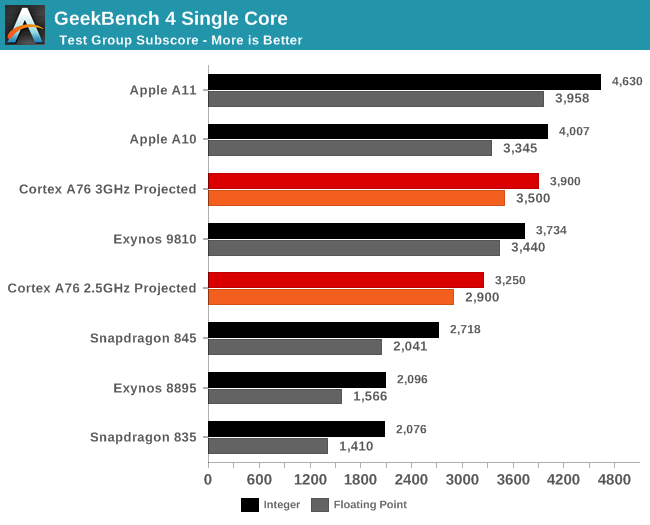
What this means in terms of absolute numbers is projected in the above graph. Baselining on the performance of the Snapdragon 835 and Snapdragon 845 a future SoC with an A76, 512KB L2’s and 2MB L3 would fall in around the GeekBench4 performance of the Exynos 9810 depending if the target 3GHz is reached.
In the past Arm has been overly optimistic when releasing frequency targets – for example the A73 was first projected at up to 2.8GHz and the Cortex A75 projected at up to 3GHz. In the end both ended up at no higher than 2.45GHz and 2.8GHz.
I’ve talked to a vendor about this and it seems Arm doesn’t take into consideration all corners when doing timing signoff, and in particular vendors have to take into consideration process variations which result in differently binned units, some of which might not reach the target frequencies. As mobile chips generally aren’t performance binned but rather power binned, vendors need to lower the target clock to get sufficient volume for commercialisation which results in slightly reduced clocks compared to what Arm usually talks about.
For the first A76 implementations in mobile devices I’m adamant that we won’t be seeing 3GHz SKUs but rather frequencies around 2.5GHz. Arm is still confident that we’ll see 3GHz SoCs but I’m going to be rather on the conservative side and be talking about 2.5GHz and 3GHz projections alongside each other, with the latter more of a projection of future higher TDP platforms.
Arm also had a slide demonstrating absolute peak performance at frequencies of 3.3GHz. The important thing to note here was that this scenario exceeded 5W and the performance would be reduced to get under that TDP target. It wasn’t clear if this was SoC power or solely CPU power – I’ll follow up with a clarification after I reach out to Arm.
Obviously the most important metric here alongside the performance improvements is the power and efficiency targets. In target products comparing Cortex A75 on a 10nm process versus a Cortex A76 on a 7nm process under the same 750mW/core power budget, the Cortex A76 delivers 40% more performance.
In terms of energy efficiency, a 7nm A76 at a performance target of 20 SPECint2006 of an A75 on 10nm (meaning maximum performance at 2.8GHz) is said to use half the amount of energy.
What is important in all these metrics again is that we weren’t presented an ISO-process comparison or a comparison at maximum performance of the A76 at 3GHz, so we’re left with quite a bit of guesswork in terms of projecting the end energy efficiency difference in products. TSMC promises a 40% drop in power versus 10FF. We haven’t seen an A75 implemented on a TSMC process to date so the best baseline we have is Qualcomm’s Snapdragon 845 on Samsung 10LPP which should slightly outperform 10FF.
Going through my projected data on one side we have performance on the right side: I baselined the SPECspeed scores on the average of the Snapdragon 835 and Kirin 970 measured results and applied Arm’s projected IPC claims and scaled the scores for frequency. For the 3GHz A76 projection this gets us the near 2x performance improvements in SPECint2006 vs the A73 generation of cores.
In terms of power efficiency, there’s more guesswork as the only real figure we have is as earlier stated the process scaled efficiency figures. Arm quoted a performance target of 20 SPECint2006 which I suspect is a 2.8GHz A75 run with GCC compiled benchmark binaries which have an advantage over my LLVM figures. If Arm wanted to compare against the Snapdragon 845 this matches roughly a 2.4GHz A76. Accounting for the process power improvement this roughly leaves a ~15% microarchitectural advantage for the A76. However as the A76 is targeted to perform 35% higher, and as we’ve seen in the past performance increases through clock don’t scale linearly with power, the power and efficiency advantages would very quickly degrade at peak performance.
Taking all factor into account as best as I could, we should be seeing 7nm A76 based SoCs beat slightly beat the energy efficiency of current Arm SoCs in terms of absolute energy usage at peak performance, a metric which is important as it is directly proportional to a device’s battery life. At a more conservative 2.5GHz clock this energy efficiency advantage would be greater and around 30% less energy than current generation A73 and A75 SoCs.
So on one hand the A76 would be extremely energy efficient, but also it could very well be a thermally constrained design as its peak performance we’d be seeing quite higher TDP figures. Arm states that the A76 is meant to run at full frequency in quad-core mode, however that claim is limited to larger form-factors, as for mobile devices, based on what I’m hearing vendors, will need to tone it down to lower clocks in order to fit smartphone designs.
Again the projection here contain a lot of variables and I’m erring towards the more conservative side in terms of performance and efficiency- however it’s clear that the jump will be significant in whichever way vendors will decide to push the A76 in (Performance or efficiency).


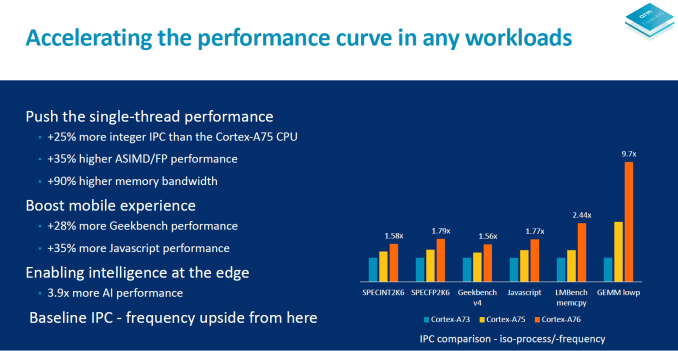

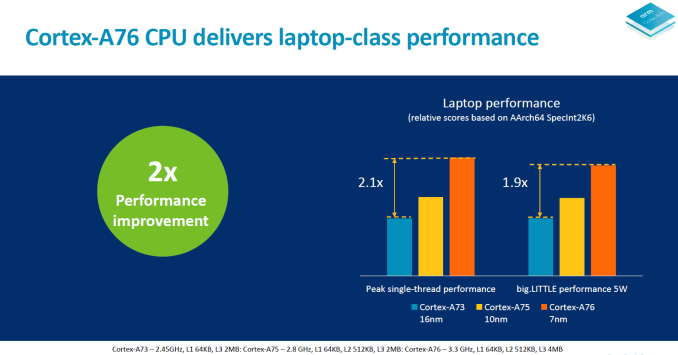
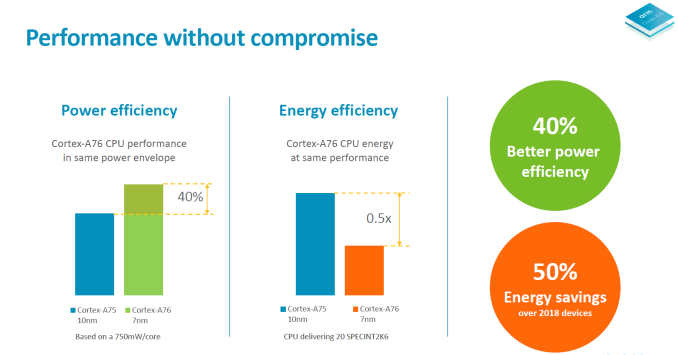
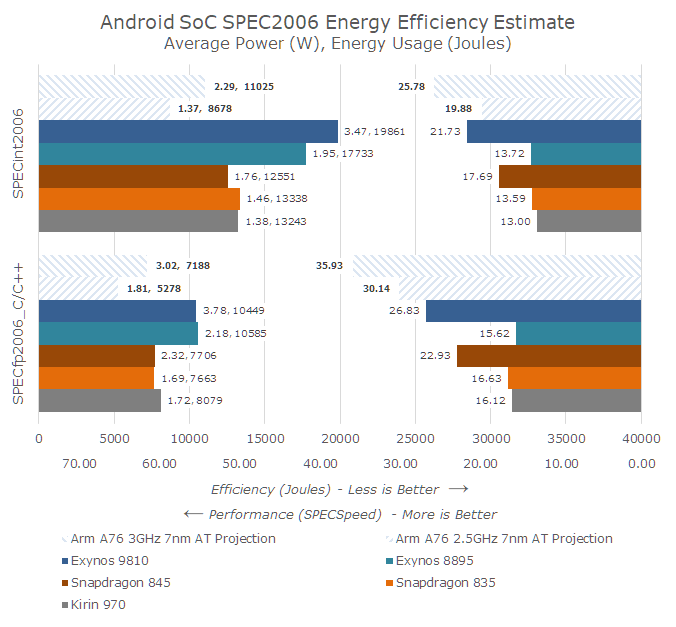














123 Comments
View All Comments
tipoo - Thursday, May 31, 2018 - link
Still a 4-wide front end, I don't imagine it'll catch A10, maybe A9 per core then eh.wicketr - Thursday, May 31, 2018 - link
I just don't understand why ARM doesn't at least come out with a design that can match the Monsoon cores of an A11, or even the power of what will likely be the next A12 cores. It seems like ARM is eternally 2-3 steps behind Apple on this and they need to catch up.shadowx360 - Thursday, May 31, 2018 - link
Probably their power/efficiency constraints. They manage to get the same performance as a M3 core with a 4 wide instead of 6 wide decoder and half the power usage. The A11 cores are absolute monsters at power draw at max performance but Apple is able to tweak the hell out of the rest of the device and OS to get the battery life in check. Android OEMs don't have that much control.wicketr - Thursday, May 31, 2018 - link
And I could understand the power issues for phones, but not all ARM chips are destined for phones. Some can go into cars or gaming consoles that are always plugged in and well ventilated.I just think they should come out with another tier ( Cortex A9X series) that can go toe-to-toe with Apple's best even if it is too power hungry for phones. Just come up with a design and see where we're at.
Wilco1 - Thursday, May 31, 2018 - link
Using a much larger core to get modest extra performance wouldn't make sense even in less power constrained cases. Not every market is happy with just 2 huge cores, so power and area efficiency remain important. For laptops binning for frequency and adding turbo modes would make far more sense.BillBear - Friday, June 1, 2018 - link
>Using a much larger core to get modest extra performance wouldn't make sense even in less power constrained cases.It makes perfect sense if you don't care that your core is large, because you aren't just selling a SOC. For Qualcomm, increased die size means reduced profit. For Apple, it does not.
For instance, Apple's Cyclone core from 2013:
>With six decoders and nine ports to execution units, Cyclone is big. As I mentioned before, it's bigger than anything else that goes in a phone. Apple didn't build a Krait/Silvermont competitor, it built something much closer to Intel's big cores. At the launch of the iPhone 5s, Apple referred to the A7 as being "desktop class" - it turns out that wasn't an exaggeration.
https://www.anandtech.com/show/7910/apples-cyclone...
Matthmaroo - Monday, June 4, 2018 - link
Apple has so many built in advantages - huge RD , excellent engineering, closed system ... android manufacturers are disadvantaged to Apple inso manu waysclose - Tuesday, June 5, 2018 - link
ARM has to build a "one size fits all" kind of solution. Unlike Apple they are not catering for a single customer with full control over every aspect of HW and SW development, and the profits associated with that.Plus, achieving the power that the Apple cores bring doesn't come cheap. Samsung's Exynos is still lagging behind and it's not like Samsung doesn't have expertise or deep pockets.
techconc - Tuesday, June 5, 2018 - link
Yeah, but when you have a big little architecture, OEMs could choose the most efficient combination to meet their needs. There needs to be a powerful single core option that's available for the ARM platform. Until ARM goes there, the rest of the ARM community will be behind Apple. Remember, not all workloads can take advantage of multiple cores. At best ARM will be approaching 2016 level Apple A series core performance.bananaforscale - Saturday, June 9, 2018 - link
Excellent engineering? Like the bendgate, touch screen problems etc. that were *engineering screwups*?